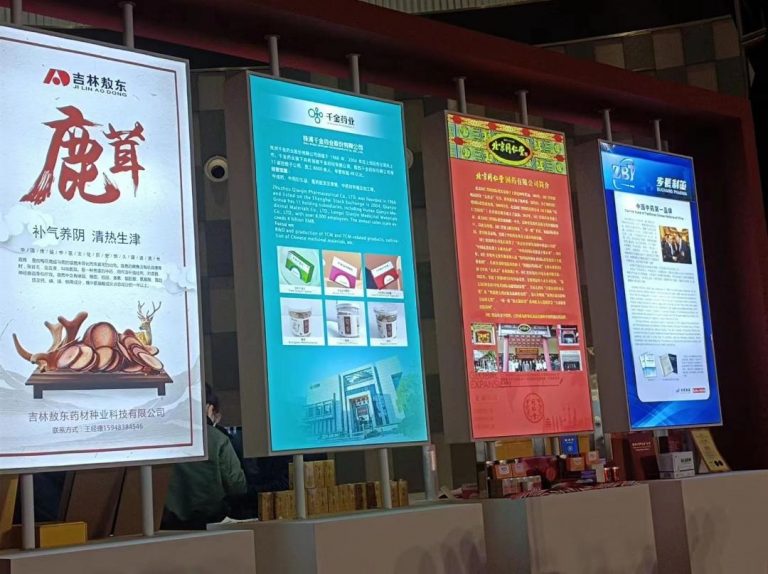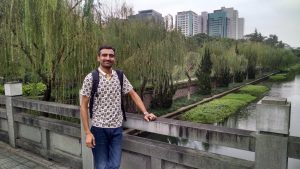
In Pakistan, Traditional Chinese medicine is not extensively used or accepted as a standard method of treatment; a few practitioners are working in Pakistan but the government does not formally recognize or regulate them
By Bukhari Zulfiqar Shah
Xian, China
2023 Gansu (Dingxi) Traditional Chinese Medicine Industry International Investment Fair was held in Longxi County, Dingxi City, Gansu Province.
In the form of online and offline dual channels, the conference was aimed to build an investment platform for Chinese medicine, economic and trade cooperation through dialogues and exchanges, investment promotion, exhibitions, field visits, matchmaking and negotiation; explore business opportunities for cooperation with ASEAN countries and regions in the traditional Chinese medicine industry, and promote the high-quality development of the traditional Chinese medicine industry in the province.
The delegation of four Pakistanis – Bukhari Zulfiqar Shah, Shahzad Salman, Muhammad Faisal, and Ms. Swera attended the conference.
The event was organized by Gansu Provincial Department of Commerce China-ASEAN Business Council Dingxi city government and the Council for the Promotion of International Trade (CCPIT), Gansu Province.
Mr. Xu Ningning Chairman of the China-ASEAN Business Council, presided over the opening ceremony. Wang Shangxue, Secretary of the Communist Party of China Dingxi City Gansu welcomed the executives from government and private sectors representatives of traditional Chinese medicine enterprises both inside and outside China.
For over a thousand years, traditional Chinese medicine (TCM) has been used in China. It is believed that Chinese medicines started from the time of Shen Nong, who was the ruler in ancient China and was known for his knowledge of plants. At the time, he was able to identify hundreds of plants, including some dangerous ones. The Huangdi Neijing, which was originally recorded in the third century BCE, provides the fundamental idea and application of Chinese medicine today. Traditional Chinese medicine encompasses more than just treatment regimens; it is also linked to philosophical views, religious ideals, and treatments including Chinese acupuncture, exercise, and food. Both in the West and in many Asian nations, these techniques and practices are still in use.
TCM is thriving once again as a result of the Belt and Road Initiative. Even though BRI is primarily an economic endeavor, together with the World Health Organization, it has made a significant contribution to the advancement of world health. In a BRI high-level meeting, the director general of WHO stated that the project needs for coordinated efforts to fulfill basic demands, such as those for infrastructure, human resources, and access to medicine worldwide. In order to promote the collective efforts of BRI nations for the avoidance of communicable illnesses, improvement in health policies, medical training, TCM, health education, and disaster management system, the BRI project’s Health Silk Road is a key undertaking.
 A Memorandum of Understanding (MoU) on medical cooperation has been signed by Tang International Education Group (TIEG) and Pakistan’s Islamia University of Bahawalpur (IUB), according to news reports in Pakistan. The agreement aims to strengthen bilateral cooperation in traditional Chinese medicine (TCM). The China-Pakistan Health Corridor, which has been running for some time and will be advanced through educational partnership, is one of the factors driving the cooperation. In terms of administration, research, and manufacturing, Traditional Chinese Medicine (TCM) and Unani Tibb (Traditional Medicine in Pakistan) collaborate extensively.
A Memorandum of Understanding (MoU) on medical cooperation has been signed by Tang International Education Group (TIEG) and Pakistan’s Islamia University of Bahawalpur (IUB), according to news reports in Pakistan. The agreement aims to strengthen bilateral cooperation in traditional Chinese medicine (TCM). The China-Pakistan Health Corridor, which has been running for some time and will be advanced through educational partnership, is one of the factors driving the cooperation. In terms of administration, research, and manufacturing, Traditional Chinese Medicine (TCM) and Unani Tibb (Traditional Medicine in Pakistan) collaborate extensively.
In the beginning of 2023, Pakistan’s Sindh Province’s health officials launched a campaign that called for China to help the nation train doctors skilled in TCM. The first group of 10 young doctors have to be chosen, and they will be sent to the center to complete a two-year TCM theoretical learning and clinical practice program. They will practice TCM diagnosis and treatment when they return to their homes following the training. This is the preliminary exploration of SPCCTCM in the training of Pakistani TCM talents. An event was also held in Islamabad to mark the return of Pakistani plant seeds from the Chinese space station. A bag containing around seven species of Pakistani herbal seeds was displayed at the event, marking the achievement of cooperation between the two sides in the field of joint breeding. Researchers at the SPCCTCM will use these seeds to carry out breeding research and study the differences between planting on Earth and in space. In terms of breeding, the study’s findings will be helpful for our Chinese medicine as well as Pakistani botanicals, particularly in terms of enhancing efficacy. China plans to establish 20 TCM international standards, register 100 TCM goods, and create 30 TCM centers abroad in nations participating in the BRI. Through new hospital alliances and a health policy research network, for example, the BRI program aims to improve contacts between academics and healthcare practitioners and broaden awareness of TCM. An estimated $50 billion is traded globally in TCM services, including medical tourism, teaching, and training in clinics. TCM has grown to be an essential component of China’s commercial and health cooperation with the ASEAN, EU, Africa, and Central and Eastern Europe.
In Pakistan, Traditional Chinese medicine (TCM) is not extensively used or accepted as a standard method of treatment. Allopathic medicine, which is based on Western medical concepts and practices, is the primary emphasis of the Pakistani government and healthcare system. Like other complementary and alternative therapies, TCM is becoming more popular in Pakistan. Many people are turning to TCM practitioners for therapy, especially for long-term diseases like diabetes and arthritis. Pakistani herbal remedies have also a wealth of experience treating skin and respiratory conditions, and their goods are sold to Central Asia and other nations. Pakistanis are quite open to TCM and are used to receiving herbal medications.
Although there are a few TCM practitioners working in Pakistan, the government does not formally recognize or regulate them. As a result, TCM practice in Pakistan is not standardized, making it challenging for patients to be sure they are getting safe and efficient care.

In conclusion, while there is some interest in TCM in Pakistan, it is not widely recognized or practiced in the country, and there are no official regulations governing its practice. But, in the current situation, BRI countries also have the chance to worldwide promote their own systems of alternative and complementary medicine, including as Ayurveda, homeopathy, and Unani medicines. China-Pakistan Economic Corridor (CPEC), a centerpiece project of BRI, aims to swiftly upgrade Pakistan’s infrastructure and boost its economy via a variety of projects totaling around $62 billion. In this situation, it is crucial for scientists, industry leaders, herbal practitioners, and policymakers in Pakistan to investigate the chance presented by BRI and CPEC to advance the herbal business by adapting TCM techniques. As the Pakistan has a great diversity in medicinal flora and people use these ethno-medicines to deal with many skin problems. The Sustainable Development Goals (SDGs) will be far closer to being achieved internationally as a consequence of this, and the herbal industries will be encouraged to grow on sound scientific and legal foundations. Pakistan only has a preliminary study and application of herbal medicine. A lot of valuable herbal plants are wasted during processing which can be better use of such resources and explore more. TCM education and ensued industrial collaboration in Pakistan will bring affordable medical services to the local people.
_______________